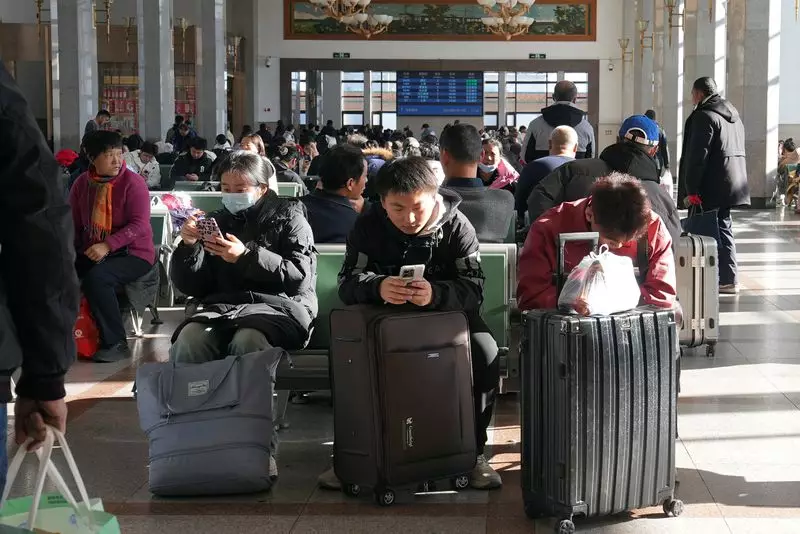The Lunar New Year represents a time of celebration and reconnection for many in China, a country experiencing both bittersweet transitions and rejuvenation. This year, travel across the nation surged as millions prepared to return to their roots for family dinners and festivities, despite impending economic headwinds. The 40-day travel season kicked off recently, spotlighting the contrast between cultural traditions and economic realities as families sought the warmth of home during this festive period.
The travel rush commenced with notable optimism, evidenced by the first train leaving Beijing shortly after midnight. This symbolic departure marked the opening of an extensive travel period, which will see an estimated 9 billion domestic trips nationwide. While authorities anticipate that railway travel will cater to over 510 million passengers, flying is expected to accommodate a substantial 90 million travelers. However, a striking majority—around 80%—will rely on private vehicles, showcasing a significant preference for more personalized and flexible travel choices amidst crowded public transportation systems.
This surge in travel highlights a familiar African proverb: “If you want to go fast, go alone; if you want to go far, go together.” Family gatherings form the emotional heartbeat of the Lunar New Year, underscoring the importance of nurturing close ties even when economic uncertainties loom over day-to-day lives. As people embark on their journeys, a myriad of wishes for smoother travel and joyful reunions resonate from every train and bus station.
While the prospect of reuniting with loved ones generally elicits joy, the backdrop of economic instability in China cannot be ignored. Many citizens are imbued with a sense of resilience and optimism despite the recent downturn. For example, individuals like Wang Zhixu remain undeterred, emphasizing the need to celebrate the Lunar New Year, regardless of the prevailing economic conditions. His sentiment encapsulates a collective refusal to let financial constraints overshadow personal joy and community spirit.
Air travel patterns further exhibit this festive optimism. Reports indicate a 50% increase in passengers opting for multiple-stop tickets, reflecting a desire to be with various family members across different locations. Not only are people seeking to bridge distances, but accommodations like hotels in popular destinations also see a notable rise in bookings, suggesting that many are determined to enjoy the holiday, even in uncertain circumstances.
Amid all this festivity lies a stark contrast—youth unemployment remains a pressing issue. Young people joining the festive travel may face different realities once the celebrations conclude. The stark statistic that youth unemployment reached 18.8% illustrates the uphill battle many young graduates face in securing desirable job opportunities. Conversations amongst travelers such as 22-year-old Shi Zhenyue reflect these anxieties, as she expressed hope for a brighter job market that might curtail the need for further academic pursuits.
The pressure on the younger demographic echoes across cities as many yield to low-paying jobs or withdraw from the hectic urban grind in search of a simpler existence. This social shift signals a growing disenchantment with big cities, prompting some to seek solace in familiar, less stressful environments. For individuals like He, who opted for a quieter life in a smaller town, the choice represents not an abandonment of aspirations, but rather a reassessment of what constitutes happiness and success.
Celebrations as a Catalyst for Connection
Despite the challenges, the festive period serves as a crucial opportunity for connection, introspection, and community building. Individuals from diverse backgrounds, whether venturing from bustling metropolises or quiet towns, come together during this time to forge lasting memories. These gatherings offer more than just culinary delights; they nurture the core of familial bonds that stand resilient in the face of adversity.
As the celebrations unfold and families share laughter and warmth, they become key players in a narrative that promotes hope amidst chaos. The Lunar New Year reminds us that, despite economic challenges, the spirit of unity and tradition holds the potential to lift spirits, allowing for reflection on shared experiences and future aspirations.
As travel dates draw near and festivities commence, the essence of the Lunar New Year reveals a duality: a celebration of cultural heritage wrapped around the complexities of modern life. From the bustling terminals to cozy family dinners, the determination to uphold tradition will undoubtedly shape the narrative of this year’s festivities across China.

